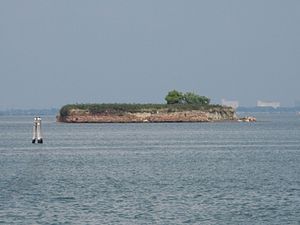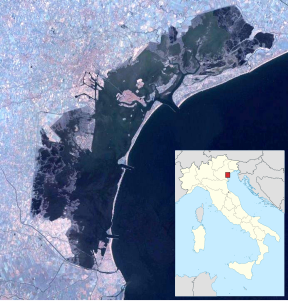Ottagono Abbandonato
| Ottagono Abbandonato | ||
|---|---|---|
| Waters | Venice lagoon | |
| Geographical location | 45 ° 21 '49.1 " N , 12 ° 19' 18.4" E | |
|
|
||
| surface | 0.302 6 ha | |
| Residents | uninhabited | |
Ottagono Abbandonato (literally: abandoned octagon) is a small island in the central lagoon of Venice . It has an area of 3,026 m² and, as one of the four octagonal fortresses from the 16th to the 20th centuries, guarded the entrance to Malamocco .
history
Archaeological excavations were carried out under the direction of the Consiglio Nazionale delle Ricerche , which unearthed remains from Roman times, such as amphorae. It is possible that the port named by Strabo was located at the mouth of the Medoacus, today's Brenta , on the edge of what was then a much larger island. At that time it probably formed part of the edge of the lagoon.
In view of the wars with the Ottomans , which culminated in the naval battle of Lepanto in 1571 , the Senate of the Republic of Venice decided to militarily secure the entrances to the lagoon. For this purpose, four octagonal fortresses (ottagoni) were to be built. With the help of material from the neighboring canal of the Ottagono abbandonato, a 1.5 m high layer was created, partly from Roman remains, on which a 3 m high fortress was built. The cannons on the fortress island had the task of shooting at any intruders into the lagoon who had managed to break through the fortified passage of Malamocco .
During the war for the Cretan Candia , which occupied Venice from 1646 to 1669, the island was fortified even more. After that, however, the Ottagoni were neglected until renewed modernizations took place from 1726. As early as 1870, the island was known by its current name, which means nothing more than abandoned octagon. The decline began at that time and has continued since then.
As a result, the fortress has fallen into disrepair and the area of the island has been significantly reduced by erosion.
Web links
- Ottagono abbandonato, website of the Comune di Venezia ( Memento of September 19, 2009 in the Internet Archive ), archive.org, September 19, 2009
- Augusto Pulliero: I racconti dell'Ottagono "abbandonato" , 2002
Remarks
- ↑ Venice Islands ( memento of March 24, 2009 in the Internet Archive ), archive.org, March 24, 2009.
- Jump up ↑ Paola Furlanetto, Aldino Bondesan, Luigi Fozzati, Ernesto Canal , Roberto Rosselli, Barbara Bertani: Siti archeologici a rischio di erosione nella laguna di Venezia. Evoluzione geomorfologica e popolamento antico, in: Geologia dell'Ambiente, Supplemento al n. 1, 2012, pp. 41–46, here: p. 46.

